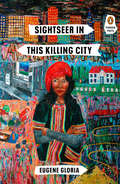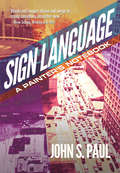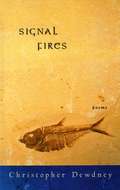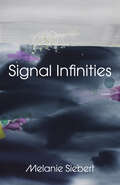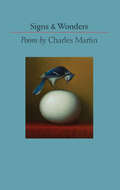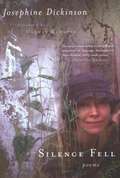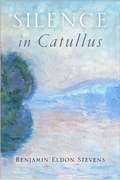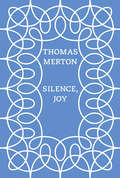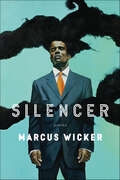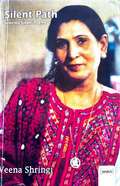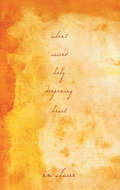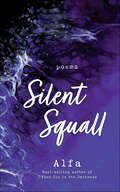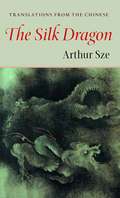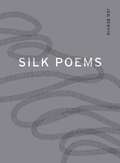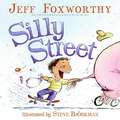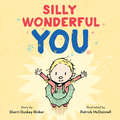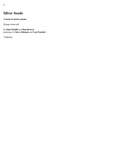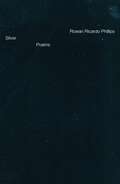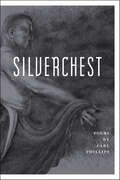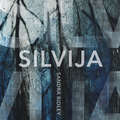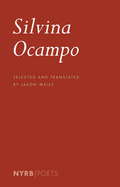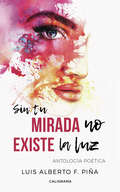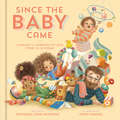- Table View
- List View
Sightseer in This Killing City (Penguin Poets)
by Eugene GloriaA fourth collection from a prize-winning poet whose "gift is breathtaking" (Naomi Shihab Nye)Eugene Gloria's Sightseer in This Killing City captures the surreal and disorienting feelings of the present. In the wake of recent presidential elections in the United States and in the Philippines, Gloria's latest collection sharpens his obsession with arrivals and departures, gun violence, displacement, cultural legacy, and the bitter divisions in America. Through the voice of Nacirema, the central persona of the collection, we are introduced to a character who chooses mystery and inhabits landscapes fraught with beauty and brutality. Gloria quotes melodies from seventies soul and jazz, blending the urban lament of Thelonious Monk and John Coltrane with the idiom of Stevie Wonder and Fela Kuti. Sightseer in this Killing City is an argument for grace and perseverance in an era of bombast and bullies.
Sign Language
by John S. PaulIn photos, drawings and words, Sign Language pays homage to the lost art of urban outdoor sign painting. In a working environment both novel and ambitious, author John S. Paul found success, noting, "No other job gave me such a direct impact on the urban landscape, or such physical engagement. Painting signs over Broadway in 1984 was a rare look down from the elevated height of a heroic messenger." Few books have ever provided such an insider perspective into this unique livelihood of days past. In 40 photos and 30 poems and stories, the author creates an immersion into a rarefied world on danger and beauty, raising the sense of the importance of moments and blurring the boundary between public and private space.
Signal Fires
by Christopher DewdneyChristopher Dewdney’s love for the landscape and the flora and fauna of southwestern Ontario has provoked some of the most gorgeously erotic prose ever to appear in this country. From that love, augmented by ardent research in the field, emerges a marvellously compelling, futuristic vision of time and space collapsed into near-simultaneity. Books IV and V of The Natural History of Southwestern Ontario, presented in Signal Fires, are self-contained sections of a continuing prose poem deeply satisfying in its density. The New-Old World of this long poem, written over a fifteen-year period, is sensuously and conceptually so immediate that orgasm and epiphany are one in it. This is writing, and reading, as immersion. Accompanying the natural histories in Signal Fires are poems with a different but equally involving music, lyrics of loss and redemption in which human relationships are central.
Signal Infinities: A Poem
by Melanie SiebertExpansive and moving, Signal Infinities courses with the intelligences of the body, its music and limits, in search of more enlivening, ethical relationships with each other and the earth.In Signal Infinities a therapist takes up an apprenticeship to a lake, to bare attention. Pain arrives. Collective and personal injuries and errors pile up. The glaciers and ancient forests are disappearing.Unlike the Iliad&’s soldiers, the cast of youth in this long poem harbour traumas that are internal, hidden, unsung. Yet each wounded one flickers with defiance and dignity. So too the blue-collar winds, the little brown bats and roadside ferns who send out their urgent signals.With unbridled oxygen affinity, this work attunes to submerged sensations, reflexes, tonal shifts, chemical transmissions and streaming kinesics. It seeks an ethics that respects the body&’s imperfect intercom, its private coulees and unstable weathers, its sheer limits.Amid too-little-too-late conditions, Signal Infinities floods with connections that are elemental, illuminating and wildly felt.
Signs & Wonders (Johns Hopkins: Poetry and Fiction)
by Charles MartinWinner of the CNY Book Award in Poetry of the YMCA of Greater SyracuseSigns is a noun (as in DO NOT DISTURB);Wonders (as in "with furrowed brows"), a verb. The couplet that leads into Charles Martin's fifth collection of richly inventive poems suggests that the world is to be read into and wondered over. The signs in this new work from the prize-winning American poet of formal brilliance and darkly comic sensibility are as stark as the one on a cage at the zoo that says ENDANGERED SPECIES, as surprising as those that announce the return of irony, and as enigmatic as a single word carved on a tombstone. Renowned for his translations of Ovid's Metamorphoses and the poems of Catullus, Martin brings the perspective of history to bear on the stuff of contemporary life.
Silence Fell
by Josephine DickinsonSilence Fell marks the American debut of an extraordinary poet from the remote north of England. The poems are set on a sheep farm in the northern mountains and tell the story -- in the form of a modern shepherd’s calendar -- of Josephine Dickinson’s marriage to a Cumbrian sheep farmer, a man more than twice her age, and their life together, until his death in 2004. During a reading tour in England, Galway Kinnell was introduced to Josephine Dickinson’s work. Her poems made such an impression on him that he passed the books on to his publisher and wrote a foreword for her American debut.
Silence in Catullus
by Benjamin Eldon StevensBoth passionate and artful, learned and bawdy, Catullus is one of the best-known and critically significant poets from classical antiquity. An intriguing aspect of his poetry that has been neglected by scholars is his interest in silence, from the pauses that shape everyday conversation to linguistic taboos and cultural suppressions and the absolute silence of death. In "Silence in Catullus," Benjamin Eldon Stevens offers fresh readings of this Roman poet's most important works, focusing on his purposeful evocations of silence. This deep and varied "poetics of silence" takes on many forms in Catullus's poetic corpus: underscoring the lyricism of his poetry; highlighting themes of desire, immortality-in-culture, and decay; accenting its structures and rhythms; and, Stevens suggests, even articulating underlying philosophies. Combining classical philological methods, contemporary approaches to silence in modern literature, and the most recent Catullan scholarship, this imaginative examination of Catullus offers a new interpretation of one of the ancient world's most influential and inimitable voices.
Silence, Joy
by Thomas Merton Christopher WaitAn inspiring gift-edition of poetry and prose from the world's favorite monk-poet In this day of mindless distraction, we’re desperate for reasons to put down our phones and reconnect with our spiritual selves. In time for the 50th anniversary of Thomas Merton's death in 1968, Silence, Joy is an invitation to slow down, take a breath, make a space for silence, and open up to joy. <P><P> Poet, monk, spiritual advisor, and social critic, Thomas Merton is a unique—and uniquely beloved—figure of the twentieth century, and this little rosary brings together his best-loved poems and prose. Drawn from classics like New Seeds Of Contemplation and The Way Of Chuang Tzu as well as less famous books, the writings in Silence, Joy offer the reader deep, calming stillness, flights of ecstatic praise, steadying words of wisdom, and openhearted laughter. Manna for Merton lovers and a warm embrace for novices, this slim collection is a delightful gift.
Silencer: Poems
by Marcus Wicker&“Tough talk for tough times. Silencer is both lyrical and merciless–Wicker&’s mind hums in overdrive, but with the calm and clarity of a marksman.&” —Tim Seibles, author of One Turn Around the Sun and finalist for the National Book Award A suburban park, church, a good job, a cocktail party for the literati: to many, these sound like safe places, but for a young black man these insular spaces don&’t keep out the news—and the actual threat—of gun violence and police brutality, or the biases that keeps body, property, and hope in the crosshairs. Continuing conversations begun by Citizen and Between the World and Me, Silencer sings out the dangers of unspoken taboos present on quiet Midwestern cul-de-sacs and in stifling professional settings, the dangers in closing the window on &“a rainbow coalition of cops doing calisthenics around/a six-foot, three-hundred-fifty-pound man, choked back into the earth for what/looked a lot, to me, like sport.&” Here, the language and cadences of hip-hop and academia meet prayer—these poems are crucibles, from which emerge profound allegories and subtle elegies, sharp humor and incisive critiques. &“There is not a moment in this book when you are allowed to forget the complexities of a black man's life in America. These poems evoke so much—strength, beauty, passion, fear. There is the quiet, ironic pleasure of life on a cul-de-sac juxtaposed with the tensions of always wondering when a police officer's gun or fists might get in the way of the black body. The stylistic range of these poems, the wit, and the intelligence of them offers so much to be admired. There is nothing silent about Silencer. What an outstanding second book from Marcus Wicker.&” —Roxane Gay &“Marcus Wicker&’s masterful and hard-hitting second collection is exactly the book we need in this time of malfeasance, systemic violence, and the double talk that obfuscates it all... He writes the kinds of vital, clear-eyed poems we can turn to when codeswitching slogans and online power fists no longer get the job done. These are poems whose ink is made from anger and quarter notes. They remind us that to remain silent in the face of aggression is to be complicit and to be complicit is not an option for any of us.&” —Adrian Matejka, author of The Big Smoke and finalist for the National Book Award and Pulitzer Prize&“Silencer is an important book of American poetry: wonderfully subtle, wholly original, and subversive. Politics and social realities aside, this is foremost a book that delights in language, how it sounds to the ear and plays to the mind. We have suburban complacency played against hip-hop resistance, Christian prayers uttered in the face of dread violence, real meaning pitted against materialism, and love, in its largest measure, set against ignorance.To say Silencer is a tour de force would be an understatement. What a work of true art this is, and what a gift Marcus Wicker has given to us.&”—Maurice Manning, author of One Man&’s Dark and finalist for the Pulitzer Prize "Silencer disarms and dazzles with its wisdom and full-throated wit. [This] collection snaps to attention with a soundtrack full of salty swagger and a most skillful use of formal inventions that&’ll surely knock you out. Here in these pages, sailfish and hummingbirds assert their frenetic movements on a planet simmering with racial tensions, which in turn forms its own kind of bopping and buoyant religion. What a thrill to read these poems that provoke and beg for beauty and song-calling into the darkest of nights."—Aimee Nezhukumatathil, author of Lucky Fish and poetry editor at Orion Magazin
Silent Path: Selected Sindhi Poems
by Veena ShringiSilent Path is a collection of selected Sindhi Poems by Veena Shringi which are translated into english by Dr. Vinod Asudani.
Silent Sacred Holy Deepening Heart
by Em ClaireThis collection is from the pen of Neale Donald Walsch’s wife, Em Claire. These warmly engaging poems are divided into three sections Remembering, Naked, and Forgetting.The purpose of the poetry of Em Claire is written with the intention of celebrating the Oneness of all Creation and exploring the mystery of who we are. Claire envisions her work as "a lantern in the window to which you have just this moment lead yourself, for reasons your own Self and Soul know."This is a book for those who loved the work of Hugh Prather and Rod McKuen; for those interested in using the power of language for healing and power growth. And, of course, this is a book for the many fans of Neale Donald Walsch.
Silent Squall: Poems
by AlfaA poetic portrayal of the unseen tempests of emotional and physical abuse from the bestselling author of Abandoned Breaths and I Needed a Viking.Raw and honest, the acclaimed author of I Find You in the Darkness shares her intensely personal, yet relatable stories through finely woven poetry. This new edition of Silent Squall includes an updated introduction and a brand-new chapter of modern poetry. Find understanding, comfort, and hope from the affecting poetry of Silent Squall.I have singed wings,and the edges of my heartare charred, and crispby flames of your dismissal.Yet even though I siftthrough ashes of the past,as I maneuver throughtomorrow . . . my soul’s fingerprintwill be everlasting.—Alfa
Silk Dragon
by Arthur SzeArthur Sze has rare qualifications when it comes to translating Chinese: he is an award-winning poet who was raised in both languages. A second-generation Chinese-American, Sze has gathered over 70 poems by poets who have had a profound effect on Chinese culture, American poetics and Sze's own maturation as an artist. Also included is an informative insightful essay on the methods and processes involved in translating ideogrammic poetry.MOONLIGHT NIGHTby Tu Fu can only look out alone at the moon. From Ch'ang-an I pity my children who cannot yet remember or understand.Her hair is damp in the fragrant mist. Her arms are cold in the clear light. When will we lean beside the window and the moon shine on our dried tears?Sze's anthology features poets who have become literary icons to generations of Chinese readers and scholars. Included are the poems of the great, rarely translated female poet Li Ching Chao alongside the remorseful exile poems of Su Tung-p'o. This book will prove a necessary and insightful addition to the library of any reader of poetry in translation.The poets include: T'ao Ch'ien Wang Han Wang Wei Li Po Tu Fu Po Ch -yi Tu Mu Li Shang-yin Su Tung-p'o Li Ch'ing-chao Shen Chou Chu Ta Wen I-to Yen ChenArthur Sze is the author of six previous books of poetry, including The Redshifting Web and Archipelago. He has received the Asian American Literary Award for his poetry and translation, a prestigious Lannan Literary Award, and was recently a finalist for the Leonore Marshall Poetry Prize. He teaches at the Institute of American Indian Arts.from A Painting of a CatNan Ch'uan wanted to be reborn as a water buffalo, but who did the body of the malicious cat become? Black clouds and covering snow are alike. It took thirty years for clouds to disperse, snow to melt.-Pa-ta-shan-jen (1626-1705)The Last DayWater sobs and sobs in the bamboo pipe gutter. Green tongues of banana leaves lick at the windowpanes. The four sur
Silk Poems
by Jen BervinIn conjunction with Tufts University’s Silk Lab’s cutting-edge research on liquified silk, Jen Bervin wrote a poem composed in a six-character chain that corresponds to the DNA structure of silk; modeled on the way a silkworm applies filament to its cocoon. This poem, written from the perspective of the silkworm, explores the cultural, scientific, and linguistic complexities of silk written inside the body.
Silly Sally
by Audrey Wood"Silly Sally went to town, walking backwards, upside down." And that's just the beginning... Come along with silly Sally and her silly companions as they parade into town in a most unusual way.
Silly Street
by Jeff FoxworthyAnything goes on Silly Street. There's a flying squirrel circus, pink elephant races, and even a pony that eats fried baloney. At the candy booth you can buy gummy yum noodles and rainbow jaw busters. At the hat store you can purchase a helmet, a tiara, or a halo-if you happen to be an angel. From the comedic mind of Jeff Foxworthy, author of the bestselling dirt on my shirt, comes another hilarious collection of poems. Kids will have so much fun reading these poems, they'll wish they actually lived on Silly Street.
Silly Wonderful You
by Sherri Duskey RinkerBefore YOU came along, so many things were different!But now . . .There's laughter, a house full of adventures and toys, a million little surprises. . . . And so much love.From bestselling author Sherri Duskey Rinker and award-winning artist Patrick McDonnell comes this funny and tender love letter from a parent to a child.
Silver Seeds
by Steve Johnson Lou Fancher Paul Paolilli Dan BrewerSilver seeds Tossed in the air And planted in the sky, Reaching out of the darkness, Sprouting wonder. The poems in this book, done in a creative acrostic format, show us the world of nature in a different light. Steve Johnson and Lou Fancher's glowing illustrations will give readers a new appreciation for the wonders of nature. Beginning with daybreak and ending with a beautiful interpretation of night, the poems include striking images of the sun, fog, and rain.
Silver: Poems
by Rowan Ricardo PhillipsRowan Ricardo Phillips’s fourth collection is a book as lustrous as the metal of its title. This beautiful, slender collection—small and weighted like a coin—is Rowan Ricardo Phillips at his very best. These luminous, unsparing, dreamlike poems are as lyrical as they are virtuosic. “Not the meaning,” Phillips writes, “but the meaningfulness of this mystery we call life” powers these poems as they conjure their prismatic array of characters, textures, and moods. As it reverberates through several styles (blank verse, elegy, terza rima, rhyme royal, translation, rap), Silver reimagines them with such extraordinary vision and alluring strangeness that they sound irrepressibly fresh and vibrant. From beginning to end, Silver is a collection that reflects Phillips’s guiding principle—“part physics, part faith, part void”—that all is reflected in poetry and poetry is reflected in all.This is work that brings into acute focus the singular and glorious power of poetry in our complex world.
Silverchest: Poems
by Carl Phillips"After / the afterlife, there's an afterlife."In Silverchest, his twelfth book, Carl Phillips considers how our fears and excesses, the damage we cause both to others and to ourselves, intentional and not, can lead not only to a kind of wisdom but also to renewal, maybe even joy, if we're willing to commit fully to a life in which "I love you / means what, exactly?" In poems shot through with his signature mix of eros, restless energy, and moral scrutiny, Phillips argues for the particular courage it takes to look at the self squarely—not with judgment but with understanding—and extend that self more honestly toward others. It's a risk, there's a lot to lose, but if it's true that "we'll drown anyway—why not / in color?"
Silvija
by Sandra RidleyGrief is personal and unpredictable; no two people experience it the same way, and yet, each person that comes out the other side is transformed by their experience of loss and redemption.In a sequence of five feverish elegies, Sandra Ridley's Silvija combines narrative lyric and experimental verse styles to manifest dark themes related to love and loss: the traumas of psychological suffering (isolation and confinement), physical abuse (by parent and partner), terminal illness (brain tumour and heart attack), revelation, resolution, and healing. Pulsing with the award-winning writer's signature blend of fervour and sangfroid, the serial poems in Silvija accrue into a book-length testament to a grief both personal and human, leaving readers with the redemptive grace that comes from poetry's ability to wrestle chaos into meaning.Because of its overarching themes and serial form, Silvija is best read cover-to-cover, analogous to a work of fiction, rather than a book of individual or occasional poems. In this way, and in dealing with timeless subjects of human significance, this book-length 'requiem for loss' bears comparisons to Anne Carson's Nox and Daphne Marlatt's The Given, and will resonate for the many people who have dealt with traumas of physical and mental illness, who have survived physical and/or emotional abuse, and who search for beauty after catastrophe.
Silvina Ocampo
by Silvina Ocampo Jason WeissSilvina Ocampo possessed her own special enchantment as a poet, and only now is her extraordinary poetic achievement becoming more widely recognized beyond Latin America. Remarkably, this is the first collection of Ocampo's poetry to appear in English. From her early sonnets on the native Argentine landscape, to her meditations on love's travails, to her explorations of the kinship between plant and animal realms, to her clairvoyant inquiries into history and myth and memory, readers will find the full range of Ocampo's "metaphysical lyricism" (The Independent) represented in this groundbreaking edition.he metaphysical turn in her later verse.
Simonides the Poet: Intertextuality and Reception
by Richard RawlesSimonides is tantalising and enigmatic, known both from fragments and from an extensive tradition of anecdotes. This monograph, the first in English for a generation, employs a two-part diachronic approach: Richard Rawles first reads Simonidean fragments with attention to their intertextual relationship with earlier works and traditions, and then explores Simonides through his ancient reception. In the first part, interactions between Simonides’ own poems and earlier traditions, both epic and lyric, are studied in his melic fragments and then in his elegies. The second part focuses on an important strand in Simonides’ ancient reception, concerning his supposed meanness and interest in remuneration. This is examined in Pindar’s Isthmian 2, and then in Simonides’ reception up to the Hellenistic period. The book concludes with a full reinterpretation of Theocritus 16, a poem which engages both with Simonides’ poems and with traditions about his life.
Sin tu mirada no existe la luz: Antología poética
by Luis Alberto F. PiñaLa reafirmación de los sentimientos a través de la poesía. <P><P>En unos tiempos donde los verdaderos sentimientos son cada vez más reservados, diluyéndolos en distracciones momentáneas y superficiales, irrumpe Sin tu mirada no existe la luz para reafirmar que todo tiene energía, un alma que conserva la semilla donde nacerán las emociones. <P><P>Luis Alberto F. Piña regresa a la literatura con su primer poemario para exponer el mundo a través de sus ojos: el desamor que nos persigue durante toda la vida; la sombra de la hiriente soledad, siempre acechante; las casualidades que el destino interpone ante nosotros; ese amor platónico que nunca será alcanzado, por mucho que se intente; la crítica hacia las injusticias que se siguen manteniendo en la sociedad... Sin tu mirada no existe la luz es un libro de poemas que interroga a la razón y al corazón.
Since the Baby Came: A Sibling's Learning-to-Love Story in 16 Poems
by Kathleen Long BostromThis charming, playful story-in-verse introduces children to a variety of different poetic forms while walking them through all the twists and turns of welcoming a new baby into the family.Mama is having a baby.Everything&’s starting to change.God, can you tell me what happened?Life is becoming so strange.Since the Baby Came offers a unique take on a timeless topic. The heartfelt and humorous drama unfolds completely in verse, addressing the full range of emotions a young child experiences when a new baby joins the family—from surprise and confusion to feelings of neglect and jealousy to wholehearted tenderness and affection. The book also introduces young children to the playfulness and fun of various forms of poetry, from senryu to villanelle. Look out! It&’s a diaper volcano!Forgive me for being abrupt.There isn&’t much time to explain—OH!That thing is about to erupt!
